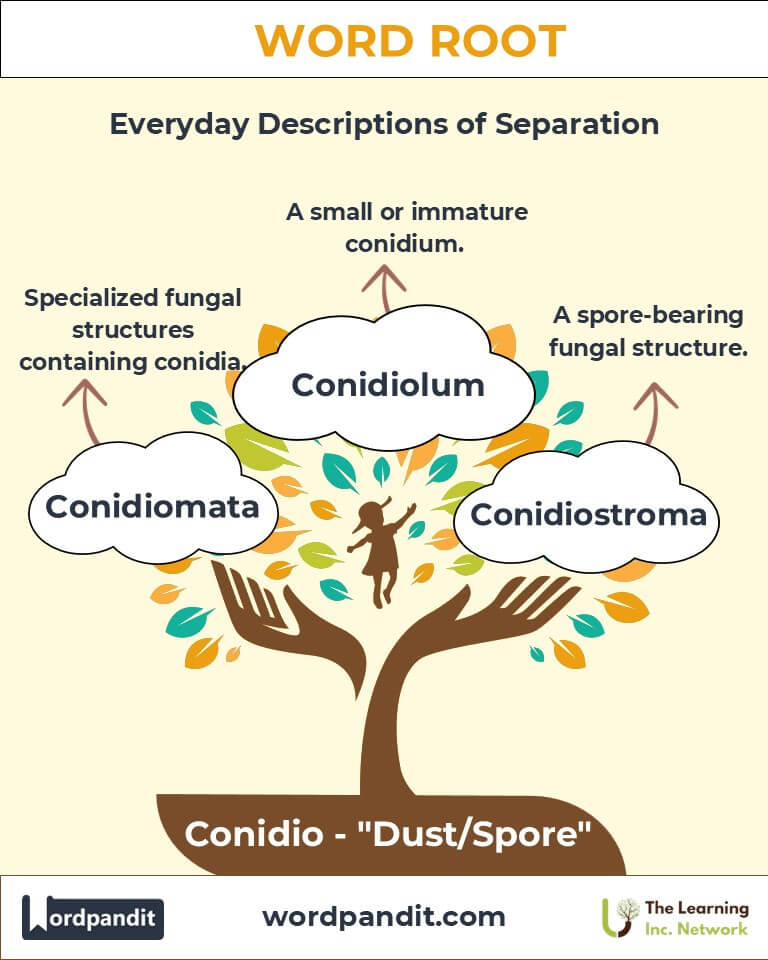Conidio: The Root of Fungal Reproduction and Growth
Discover the fascinating world of the word root "Conidio," derived from the Greek word "konis," meaning "dust," and used in biology to refer to fungal spores. Explore its relevance in scientific terminologies like conidiophore and conidiogenesis, which highlight the intricate processes of fungal reproduction and dispersal.

Table of Contents
- Introduction: The Essence of Conidio
- Etymology and Historical Journey
- Mnemonic: Unlocking the Power of Conidio
- Common Conidio-Related Terms
- Conidio Through Time
- Conidio in Specialized Fields
- Illustrative Story: Conidio in Action
- Cultural Significance of the Conidio Root
- The Conidio Family Tree
- FAQs about the Conidio Root
- Test Your Knowledge: Conidio Mastery Quiz
- Conclusion: The Living Legacy of Conidio
Introduction: The Essence of Conidio
What do you imagine when you think of "spores"? Microscopic particles floating through the air? The root "Conidio," pronounced koh-nee-dee-oh, is central to fungal biology, representing reproductive spores crucial for dispersal and survival. From laboratory research to agricultural practices, understanding Conidio connects us to the dynamic world of fungi and their role in ecosystems.

Etymology and Historical Journey
The root Conidio stems from the Greek konis, meaning "dust," reflecting the lightweight and airborne nature of fungal spores. As mycology (the study of fungi) developed, this root became integral to terms describing spore production and dissemination, such as conidiogenesis (the process of spore formation) and conidiophore (spore-bearing structures).
Mnemonic: Unlocking the Power of Conidio
Visualize a puffball mushroom releasing a cloud of tiny spores into the wind, like "dust." These spores symbolize Conidio, spreading life and ensuring the survival of fungi.
Mnemonic Device: “Conidio spreads like dust, seeding fungi far and wide.”
Common Conidio-Related Terms
- Conidiophore (koh-nee-dee-oh-fore): A specialized fungal structure that bears conidia (spores).
Example: The conidiophore releases spores that spread to new environments. - Conidiogenesis (koh-nee-dee-oh-jen-uh-sis): The process by which fungi produce conidia.
Example: Scientists study conidiogenesis to understand fungal life cycles. - Conidium (koh-nee-dee-um): A single spore produced asexually by fungi.
Example: The conidium’s structure allows it to survive harsh conditions. - Macroconidium (mak-roh-koh-nee-dee-um): A large spore type in certain fungi.
Example: Macroconidia are often studied for their role in fungal reproduction. - Microconidium (my-kroh-koh-nee-dee-um): A smaller spore type produced alongside macroconidia.
Example: Microconidia are critical for understanding fungal genetic diversity.
Conidio Through Time
- Ancient Use: Early references to spores likened them to dust due to their microscopic size.
- Modern Understanding: Advances in microscopy and genetics revealed the complexity of conidia in fungal lifecycles, serving as vectors for fungal dispersal and infection in plants and animals.
Conidio in Specialized Fields
- Agriculture: Fungal spores, including conidia, are studied for their role in crop diseases like rusts and blights. Understanding spore dispersal helps protect crops.
- Medicine: Conidia inhalation can lead to fungal infections, such as aspergillosis. Research on conidia behavior aids antifungal treatments.
- Biotechnology: Genetic engineering of fungi focuses on conidiogenesis for producing enzymes or biofuels.
Illustrative Story: Conidio in Action
In a remote forest, Dr. Elena—a mycologist—studies a rare fungus that produces vibrant conidiophores. One rainy afternoon, she observes the spores dispersing in the wind. Intrigued, she collects samples, discovering a fungus that produces antibiotics. Her findings underscore the importance of fungal conidia in medical innovation, connecting ancient processes to modern breakthroughs.
Cultural Significance of the Conidio Root
While primarily scientific, the imagery of spores as "seeds of life" resonates with themes of renewal and resilience in art and literature. Fungi’s ability to grow and thrive in diverse environments symbolizes persistence and adaptability, much like dust settling across the earth.

The Conidio Family Tree
- Spor- (Greek: "seed, spore"): Sporulation (the formation of spores).
- Phore- (Greek: "bearer, carrier"): Sporophore (a structure bearing spores).
- Myco- (Greek: "fungus"): Mycology (the study of fungi).
Test Your Knowledge: Conidio Mastery Quiz
1. What does the root "Conidio" signify?
2. What is the function of a conidiophore?
3. Which term describes spore formation?
4. What is a macroconidium?
5. What field relies heavily on conidial structures?

Conclusion: The Living Legacy of Conidio
The root Conidio embodies the fascinating world of fungal reproduction and dispersal, highlighting its impact on ecosystems, agriculture, and medicine. As research advances, understanding conidia’s role will continue to reveal the interconnectedness of life and the potential for scientific discovery.











